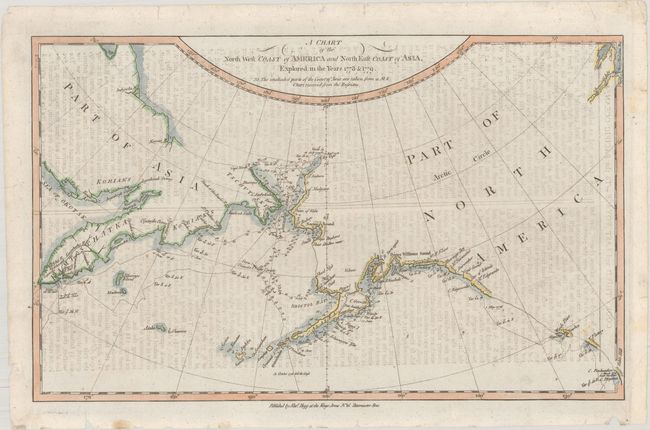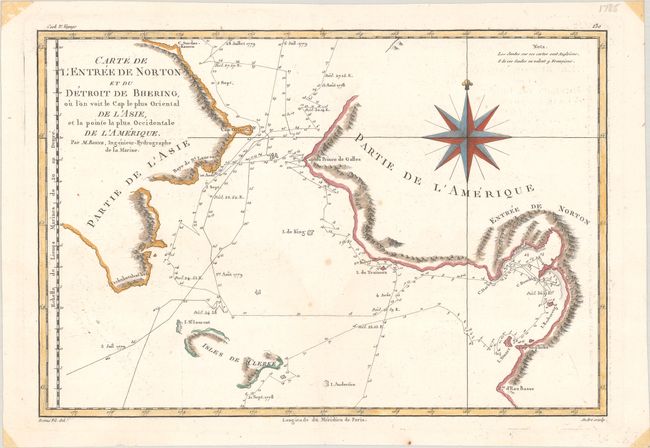Subject: North Pacific Ocean
Period: 1785-88 (circa)
Publication:
Color: Hand Color
Captain James Cook (1728-1779) is best known for his three voyages to the Pacific (1768-71; 1772-75; and 1776-79). His discoveries radically changed the western understanding of the world in the late 18th century. He was the first to circumnavigate and chart New Zealand and provided the earliest European accounts of exploration along the eastern coast of Australia and the Hawaiian Islands. On February 14th, 1779, he was killed on Hawaii after attempting to kidnap the chief of the island.
Many contemporary accounts of Cook’s voyages, including charts and engravings, appeared in the late 18th century. The first official account of Cook’s first voyage was published in 1773 by John Hawkesworth in Volumes II and III of An Account of the Voyages Undertaken by the Order of His Present Majesty for Making Discoveries in the Southern Hemisphere... William Strahan and Thomas Cadell published the first official accounts of the second and third voyages in 1777 and 1784. Accounts of his exploration were subsequently translated into French, German, and Dutch.
A. A Chart of the North West Coast of America and North East Coast of Asia, Explored in the Years 1778 & 1779, by Cook/Hogg, from A New Authentic and Complete Collection of Voyages Round the World, circa 1785 (13.8 x 8.6"). This charts traces Captain Cook's route through Alaska, the Bering Strait, and Kamchatka. It was drawn by Lt. Roberts, Master mate on the Resolution under Cook. It depicts the coastlines of Alaska, British Columbia, and Russia; a note explains that part of the information on the map was obtained from a manuscript chart received from the Russians. The ship's route is traced with navigational information including soundings. The map's detail is focused on Cook's third and final expedition (1776-79), when he traveled up the northern reach of the Pacific in search of a Northwest Passage. His routes are traced and dated. Cook probed up along the Oregon coast in bad weather to Nootka Sound, where he rested and refitted his ships. They sailed forth to the Alaskan and Chukotskiy peninsulas and from there into the Bering Strait. Cook got as far north as 70° by 41° N before being forced back by the ice off Icy Cape. The expedition came south down the Russian coast and then east to Norton Sound. Cook's expedition then sailed south to Hawaii, where Cook was killed in a dispute with the natives. His second-in-command Clerke took over the expedition and they explored further in Hawaii before returning north to continue the exploration for the Northwest Passage. Reference: Shirley (BL Atlases) G.AND-1a #4. Condition: There is light offsetting of text from an opposing page and a couple minor spots. (B+)
B. Carte de l'Entree de Norton et du Detroit de Bhering, ou l'on voit le Cap le Plus Oriental de l'Asie, et la Pointe la Plus Occidentale de l'Amerique, by Rigobert Bonne, from Atlas Encyclopedique, circa 1788 (13.6 x 9.3"). Based on the expeditions of Captain Cook, this great map covers the Bering Strait from south of Norton Sound to north of Cap du Prince de Galles and the corresponding coastline of Russia. It shows the Chukotskiy and Seward peninsulas and parts of St. Lawrence Island (here Isles de Clerke). Features include islands, place names, soundings, and hachures representing coastal mountains. The tracks of both the 1778 and 1779 explorations are delineated; Cook having done the former and Clerke the latter after Cook's death in Hawaii in February 1779. Engraved by Andre and decorated with a large compass rose. Reference: Falk (AK) #1788-2. Condition: A crisp impression with a few light spots and minor offsetting. There are remnants of hinge tape in the upper corners on recto.
References:
Condition: B+
See description above.



